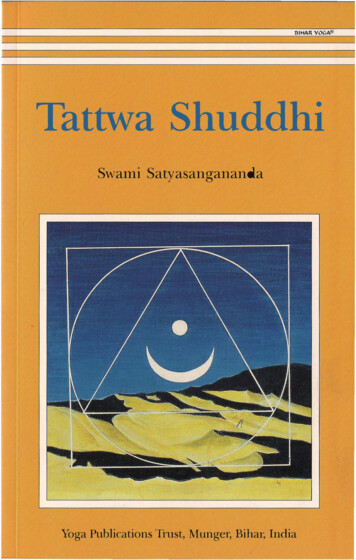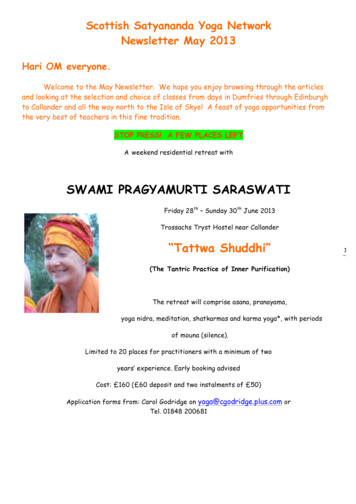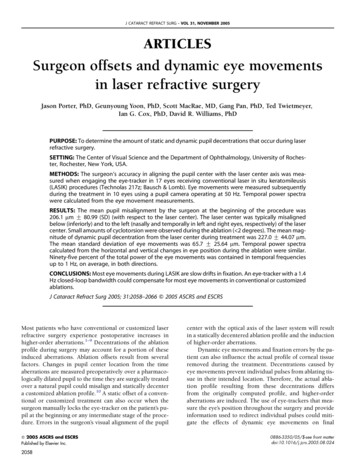
Transcription
llIHAR YOGA Tattwa ShuddhiSwami SatyasanganandaYoga Publications Trust, Munger, Bihar, India
lBIHAR YOC.ATattwa shuddhi is an ancient tantric practice of innerpurification. Every individual is composed of five basicelements or tattwas which can be purified and trans formed through the process of tattwa shuddhi. Thiscomprehensive text contains the theory of the tattwasand detailed instructions for the practice, including thetantric tools of yantra, mantra and mandala.Tattwa shuddhi is an advanced practice, which may beperformed as a sadhana in itself or as an adjunct tokundalini kriyas and other higher yogas.ISBN 81-85787-37-9Wedic {j{jkscst 200,3 978818 5 78 73 74Purveyors of fineIndological BooksWeb!lUe : www.vedlcbooks.netE:'moll : talk2us@vedlcbooks.net
Tattwa ShuddhiThe Tantric Practice ofInner PurificationSwami SatyasanganandaUnder the Guidance ofSwami Satyananda SaraswatiYoga Publications Trust, Munger, Bihar, India
SWAMI SIVANANDA SARASWATISwami Sivananda was born at Patta madai, Tamil Nadu, in 1887. After Bihar School of Yoga 1984All rights reserved. No part of this publication may be reproduced,transmitted or stored in a retrieval system, in any form or by anymeans, without permission in writing from Yoga Publications Trust.The terms Satyananda Yoga and Bihar Yoga are registeredtrademarks owned by International Yoga Fellowship Movement(IYFM). The use of the same in this book is with permission andshould not in any way be taken as affecting the validity of the marks.Published by Bihar School of YogaFirst edition 1984Reprinted 1992serving as a medical doctor in Malaya,he renounced his practice, went toRishikesh and was initiated into Dash nami sannyasa in 1924 by SwamiVishwananda Saraswati. He touredextensively throughout India, inspiringpeople to practise yoga and lead adivine life . He founded the Divine LifeSociety at Rishikesh in 1936, theSivananda Ayurvedic Pharmacy in 1945, the Yoga Vedanta Forest.Academy in 1948 and the Sivananda Eye Hospital in 1 5 . DUring his lifetime Swami Sivananda guided thousands of dIscIples andaspirants all over the world and authored over 200 books.Published by Yoga Publications TrustReprinted 2000, 2003, 2005ISBN: 81-85787-37-9Publisher and distributor: Yoga Publications Trust, Ganga Darshan,Munger, Bihar, India.Website: www.yogavision.netPrinted at Thomson Press (India) Limited, New Delhi, 110001SWAMI SATYANANDA SARASWATISwami Satyananda was born at Almora,Uttar Pradesh, in 1923. In 1943 he metSwami Sivananda in Rishikesh andadopted the Dashnami sannyasa wayof life. In 1955 he left his guru's ashramto live as a wandering mendicant andlater founded the International YogaFellowship in 1956 and the Bihar Schoolof Yoga in 1963. Over the next 20 yearsSwami Satyananda toured internation ally and authored over 80 books. In1987 he founded Sivananda Math, a charitable institution for aidingrural development, and the Yoga Research Foundation. In 198 herenounced his mission, adopting kshetra sannyasa, and now lIvesas a paramahamsa sannyasin.
ContentsSWAMI NIRANJANANANDA SARASWATISwami Niranjanananda was born inMadhya Pradesh in 1960. At the age offour he joined the Bihar School of Yogaand was initiated into Dashnami sannyasaat the age of ten. From 1971 he travelled1Introduction1 . Tantra62 . Tattwa Shuddhi in Brief18the next 11 years. In 1983 he was recalled3. Tattwa huddhi: Process of Purification24to India and appointed President of Bihar4. Tattwa Shuddhi as a Part of Tantric Worship29the development of Ganga Darshan,5 . Prana Shakti33Sivananda Math, Yoga Publications Trust6. Evolution of the Elements40paramahamsa and in 1993 anointed preceptor in succession to7. Antah Karana: Individual Mind48Swami Satyananda. Bihar Yoga Bharati was 'founded under his8 . Panchatattwa: the Five Elements569. The Individual Tattwas64overseas and toured many countries forSchool of Yoga. Since then he has guidedand the Yoga Research Foundation. In 1990 he was initiated as adirection in 1994. He has allthored over 20 books and guidesnational and international yoga programs.1 0. Tattwas and Koshas721 1 . Tattwas and the Breath751 2. Mantra, Yantra and Mandala81dorenagore, West Bengal. From the age1 3. Visualization and Imagination94of 22 she experienced a series of inner14. Bhasma: the Bath of Fire1 02Swami Satyananda. From 1981 she trav 1 5 . Practising Tattwa Shuddhi Sadhana1 07elled ceaselessly with her guru in India1 6. Effects of Tattwa Shuddhi Sadhana1 19scholar with deep insight into the yogic1 7. Guru1 25and tantric traditions as well as modernGlossary1 29SWAMI SATYASANGANANDA SARASWATISwami Satyasangananda (Satsangi) wasborn on 24th March 1953, in Chan awakenings which led her to her guru,and overseas and developed into asciences and philosophies. She is an effi- ,cient channel for the transmission of her guru's teachings. Theestablishment of Sivananda Math in Rikhiajs her creation andmission, and she guides all its activities there, working tirelessly touplift the weaker and underprivileged areas. She embodies compas sion with clear reason and is the foundation of her guru's vision.vzz
Salutations to Shaktix-rcf- - fffi- OO - ?I :IR5IcB Tf'NT ,"",1' I :Ifill SXTI cfo Shive,You are the auspiciousnessOfall auspicious things,And the fulfiller ofall purposes.You are the refuge,o Trayambake,o Cauri.Unto you, 0 Narayani,My salutations.IIntroductionIIToday yoga is practised in almost every corner of the world,but we do not really see any transformation in the conscious ness of mankind. Where then does the fault lie? Is it in thepractice itself? Not likely, because we can cite numerousexamples of cases where it has been successful. It is morelikely that the fault lies in the way we practise our sadhana; 'abit of this and a bit of that,' whenever we care to do it. Inorder to eliminate this lop-sided approach to yoga, we willhave to pay greater attention to the philosophy and practicesof tantra, which is the source of yoga.There is no use in just having a bird's eye view of asubject as vast as tantra, which has viewed existence fromevery angle or point of view. Through this 'in depth' study ofthe. pattern of creation, its manifestation, its cause and effectin relation to the individual, the tantrics discovered themissing link which unifies the individual and the cosmos.Once they had realized the way to bridge the gap, thetantrics devised methods and practices to guide others.Although these methods are inconceivably ancient, they havewithstood the test of time, for the base on which they weredeveloped, emphasized the necessity of inner experiencefor the evolution of an individual; not limited knowledge,but living breathing experience.These methods of tantra are very systematic and precise.The practices are linked in such a way that the goal of1
samadhi do s not seem like a remote possibility, but a realityyou can achIeve here and now if you desire. The desire forsamadhi is essential, for without the burning desire you cannever get there. This desire should completely overwhelmand absorb you so that no other thought exists or dissipatesthe concentrated energy forces of the mind. Samadhi, tantrasays, can be attained if only you care to look within instead ofw th ?ut. However, in order to develop the art of lookingwlthm, you have to follow the practices that have beenspecifically designed by tantra for this purpose.Therefore, tantra lays greater emphasis on practice, ratherthan the philosophy behind it. Many accomplished tantricsare not . even a ,,:are of the high-sounding philosophiesextolled m the vanous translations or commentaries on tantrabe ause they are not impressed or captured by mer phIlosophy but by the transformation of the consciousness.through its exposure to every level of experience.Therefore, in order to understand tantra, you will have todelve deep into he practices and not merely attempt to.understand It by bIts and pieces of second-hand information.Try it for yourself and then pass judgement on tantra.In order to do that, you will have to follow the procedures.deslgne? by ta tra f om beginning to end. There is little youcan achIeve by J umpmg into a lake if you don't know how toswim. Similarly, it is advised that sadhana should not bechosen on the basis of personal desires, but on that of personalgrowth and evolution, so that there is no danger of drowning.For exam le, varna m r?a, kundalini yoga and so on maysound ppealmg and eXCItmg, but unless there is a strongfoundatIOn, your sadhana is sure to dissipate. Tantra termsthis foundation for all sadhana as shuddhi or purification. owever, on this point tantra differed from other philos ophIes, for what other philosophies termed as sin, tantrate r.ned as a necessary experience for growth. Tantra says toutIl ze these forces of passion, anger, jealousy, guilt, shameand hatred by uniting them with their opposites. Only thencan you experience unity. If you misuse these forces by2creating a separation from their opposites, then the gapgrows wider and unity becomes impossible. So, tantra speaksof purifi cation but in a differ ent sense. By the termpurification it implies the release of energy from matter, sothat the energy can unite with consciousness.In order to achieve this aim of purification, tantraemployed several methods, ranging from the gro s to ubtl.eand causal levels of purification. Tattwa shuddhI, whICh . isincluded amongst these practices, stands out due to ItSeffectiveness of purification at not just one, but all leve!s. Ithas emerged as one of the most important sadhanas whICh adisciple has to undergo on his journey from the outer to theinner world.Without this purificatory process through tattwa shu dhi,the higher esoteric practices lead to darkness and despair. Itis a very simple matter to understand. Varna marga, kauladali i yogamarga, smashan sadhana, shyama sadhan or kun.require a very deep level of concentratIOn whIch I.S onlyattainable when the mind has transcended matter and VIbratesat the subtle frequency of pure energy. You have to be soproficient at attaining this state that it should happen aseasily as at the press of a button.Only then can you hope tooverpower the inner explosions that arise as a con equenceof the practices. Otherwise you will simply remam at thelevel of material awareness, or else, if you transcend matterwhile still operating through the gross mind, the re ultingexper iences are likely to create a severe error m the.personality.hISthaasadhanofviewofpoint thefromonlynotIt ispurification has to ta e plac , but eve? fro that of hvm together in a harmoDIous sOCIety.The wo ne.s .of the worldare assailing the human mind and the mdlVldual cannotcope with these traumas. Today man is at the height ofmental tension, due to his inability to understand the mechan ics of the mind.If you ask the average person, "What is mind? ",. he willtell you that it is thought. He cannot even conceive that3
mind could be anything other than the psychological make up. He does not know that, as you go deeper and deeper,you discover that hidden within these faculties is the potentialpower to create and destroy. Can you ever believe that thesame mind which causes so much conflict in your life cancreate an entire universe; that the same ego which causes thepain and misery of attachment could explode the experienceof oneness and unity; that dormant within you is the wholemystery of your life's journey from unity to diversity; thatthere exists in you a higher mind, which is the reflection ofpure untainted consciousness? The sadhana of tattwa shuddhienables the inner power of the mind to be revealed as apotential bridge through which the aspirant crawls from thetransience of objective experience to the permanence ofinner reality.Essentially, tattwa shuddhi is a system designed to purifYthe whole of man's being. It begins with the gross form ofpurification and goes on to the subtle and psychic purification,culminating in the subtle awareness which prepares theaspirant for the experience of the energy and consciousnessfrom which he has evolved. When one practices yoga over anextended period of time" it creates a mild awakening ofshakti or energy, which can be felt in the psychic levels of thebody and mind. However, tattwa shuddhi concentrates thisawakening of energy and channels it by giving it a form, thusaltering the basic awareness.Tattwa shuddhi plays a primary role, not just in thecontext of practices related to mental, psychic and spiritualdevelopment, but even in those practices where the healingand curative processes are concerned. If tattwa shuddhi werepractised before. hatha yoga and the practices of yoga therapy,the result would be quicker and more enduring. Hatha yogapractitioners must understand that the body with which theyare dealing is an aggregate and composite of five tattwas orelements, and hence tattwa shuddhi has a direct influenceon the effects of the shatkarmas. Shatkarmas are also processesof purification of the body, but their influence is limited to4the body's triple humours. Their effects do not stretch tothe remoteness of the subtler layers, which can be achievedthrough tattwa shuddhi.Tattwa shuddhi is the basis of all sadhana because itaccomplishes the major spade work. Just as a farmer tills theland, fertilizes it properly, and then sows the seeds, similarlyan aspirant first prepares the mind and body through tattwashuddhi, then develops the richness of his inner experience.5
1Tantrahe aim of tantra is succinctly defined in the word itself.TTantra has been derived from the combination of twoSanskrit words: tanoti or expansion and trayati or liberation.This implies that tantra is the method to expand the mindand liberate the dormant potential energy. In order tounderstand tantra we have first to comprehend exactly whatis meant by expansion of mind and liberation of energy.The range of our experience related to the inner andouter world is usually severely limit
Tattwa Shuddhi Swami Satyasangananda Yoga Publications Trust, Munger, Bihar, India . BIHAR YOC.A Tattwa shuddhi is an ancient tantric practice of inner purification. Every individual is composed of five basic elements or tattwas which can be purified and trans formed through the process of tattwa shuddhi. This comprehensive text contains the theory of the tattwas and detailed instructions .










